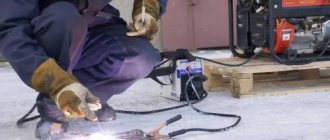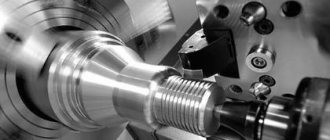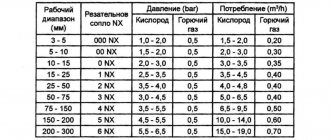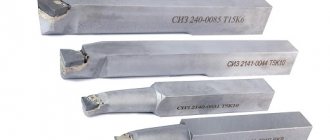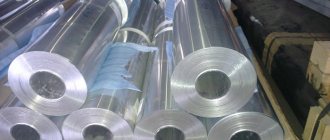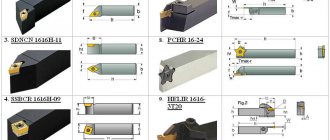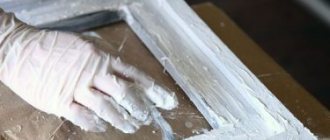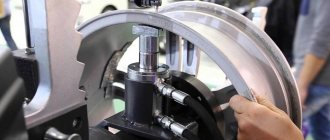08/28/2019 Author: VT-METALL
Issues discussed in the material:
- What are the features of cutting aluminum profiles with hand tools?
- How to cut aluminum profiles on an industrial scale
- How to cut an aluminum profile on CNC machines
The technology for cutting aluminum profiles should be selected taking into account the volume of work and the characteristics of the workpiece. If you have to cut a small batch of thin aluminum profiles, you can resort to hand tools or a portable power saw. If the material is thick or cutting of aluminum profiles is planned as mass production, special equipment will be needed.
Hacksaw for metal
When finishing buildings during the construction process, specialists come to the rescue with a miter saw, with which they can cut a sheet of metal. However, it is not always appropriate to use a power tool. For a gentle approach, choose a manual device such as a simple and reliable hacksaw.
There are special blades designed for cutting soft and non-ferrous metals Source Farpost.ru
Cutting aluminum sheets that do not have a large cross-section has several disadvantages, namely:
- an inconvenient work format, during which the specialist is forced to simultaneously fix the profile and perform movements. Because of this, the quality of the product decreases;
- during the cutting process, the material loses its original shape;
- manual processing takes longer than machine processing.
How to cut aluminum at home? — Handyman's Handbook
Hello colleagues! Sheet aluminum cutting is carried out for the purpose of cutting the metal sheet into parts. Thanks to this process, it is possible to obtain a workpiece that fully complies with the specified parameters, make cutting virtually waste-free, and produce parts of non-standard shapes and sizes.
Plasma metal cutting: technology
At different times, many mechanical and thermal technologies were adapted for cutting aluminum sheets - metal was cut and continues to be cut using the following types of machines:
- turning;
- milling;
- laser;
- waterjet;
- gas-oxygen,
- cutting,
- boring;
- guillotines.
We talked about them in more detail in this post.
The parts were also given the required shape using drilling presses, drilling machines, bushing machines, and other specialized equipment.
All of these methods have a lot of advantages and disadvantages, but today they are all considered outdated, although they continue to be used in many enterprises.
The most advanced and modern is plasma cutting of aluminum and other metals, such as stainless steel, provided by.
The advantages of the method become most obvious when working with soft metals and alloys.
When cutting, a computer numerical control (CNC) machine is used.
The technology of the method consists in using gas heated to a temperature of 5000-30000°C and using an electrode enriched with electrically charged particles.
For cutting aluminum sheets, as for plasma processing of other non-ferrous metals, one of the inactive plasma-forming gases (hydrogen, nitrogen, argon) is used. A jet of gas is directed onto the sheet through an electric arc, resulting in a flawless cut.
Plasma cutting of aluminum: advantages of the method
Compared to laser and other types of metal cutting, the plasma method has a number of undeniable advantages, thanks to which more and more manufacturers prefer it to other types of processing of ferrous and non-ferrous metals:
- Quality and high precision of cutting : the cut of aluminum after processing by the machine has practically no scale, which increases the accuracy of the parameters of the resulting workpiece. The excellent quality of the parts is ensured by the additional high speed of the process, which reduces the heating of the sheet to a minimum - this factor helps to avoid deformation of even the thinnest raw materials. The low temperature of the working process made it possible to accurately process even sheets with a thickness of 1-6 mm (which is absolutely impossible when working with thin sheet aluminum on an oxygen-gas machine, since it leads to overheating and deformation of the sheet). This makes production virtually waste-free, reduces the likelihood of receiving defective parts to zero, and allows you to keep the price of work to a minimum. In addition, plasma cutting technology makes it possible to process several sheets simultaneously.
- Ease of control - thanks to CNC and other technical characteristics of the device (compactness, good visibility for the operator), metal cutting has become simpler and more convenient.
- High speed of the production process : compared to oxygen-gas cutting, processing even thick sheets (≈25 mm) now takes 12 times less time, which allows for maximum production capacity.
- Economical . The production of aluminum workpieces per unit costs less than the cost of laser and gas-oxygen cutting, including due to the absence of the need for re-processing of manufactured parts. The cost of services is also positively affected by the fact that only electricity and compressed air are involved in the process - this allows you to save on consumables (purchase of fuel gas, its delivery, loading and unloading, storage space, rental of containers). The result is a low price of blanks and saving money for the customer.
- Safe technology . CNC plasma cutting systems operate without the use of flammable gas and therefore do not pose an increased fire hazard or injury to device operators, and therefore do not require mandatory insurance, as when working with other types of machines. Simplicity of operations, compactness of equipment, reliable and safe working conditions - these factors greatly simplify aluminum cutting, increase productivity, reduce to zero the likelihood of force majeure, and guarantee uninterrupted work and its completion within the agreed time frame.
- Wide range of possibilities : plasma is used for cutting not only aluminum, but also other metals and alloys (non-ferrous, ferrous, stainless).
A strong argument in favor of cutting aluminum with plasma is also the absence of the need for preliminary preparation of raw materials - the metal for cutting can be dirty, dusty, covered with old or even peeling paint. This will not have any effect on the quality and accuracy of cutting, the error of which is only ±1.2mm.
Cutting sheet aluminum in
By ordering the service of cutting aluminum sheets from our company, you receive:
- fast and friendly service;
- economically reasonable prices;
- extremely reduced minimum order cost;
- competent consultation, careful preliminary calculation of the order according to the drawings;
- order fulfillment in a short time;
- excellent quality of the resulting products;
- payment upon completion of work;
- cooperation throughout Russia (Moscow, Moscow region, other regions).
Aluminum plasma cutting is trusted by leading Russian manufacturers due to its accuracy, speed and reliability, which ensures their high productivity and increased profits.
Methods for cutting aluminum profiles
Conventionally, all methods are divided into two groups:
- cutting with compact manual or electric equipment;
- cutting with special devices (portable or stationary).
The first group includes the following tools:
The second category includes:
- plasma, laser, milling installations;
- various saws.
Now it’s worth studying the features of each method, advantages and disadvantages, and then draw a conclusion about the best method for cutting aluminum profiles.
Hacksaw for metal
It is not always possible to use electrical equipment like miter saws, so you have to be content with the simplest tools. The first of them is hacksaws for metal. They can cut sheet material, as well as profiles of small thickness. Cutting starts from the edge, continues on the back and ends on the sides.
Advantages:
- the hacksaw weighs little, so your hands don’t get tired;
- ease of operation;
- cheapness of the tool;
- Works as efficiently as a jigsaw.
Flaws:
- takes a lot of time;
- possible profile deformation;
- the need to hold the profile, which does not guarantee accuracy of work.
Metal scissors
An even simpler tool that is easier to work with. The principle of operation is elementary - the profile is marked and then cut along the line.
Advantages:
- cutting occurs faster than with a hacksaw;
- cheap scissors;
- A good result is possible if you have high-quality tools and experience.
Flaws:
- when crossing the profile ribs, it is possible to leave the marking line, damage the workpiece or bend it;
- you will have to practice and ruin several “rough” blanks before you can work perfectly accurately.
Electric jigsaw
Before work, it is important to make sure that the tool is equipped with a file specifically for metal. Of course, a wood blade will also cut aluminum, but the quality of the cut will leave much to be desired. The cutting of the profile begins from the back part, then the side edges are sawed in turn.
Advantages:
- electrical equipment makes the user's work easier;
- quality close to ideal (the product will not have burrs, bevels, or other defects);
- speed of work;
- reusability (with the right choice of file);
- A jigsaw is cheaper than similar devices for cutting aluminum profiles.
Flaws:
- the workpiece must be securely fixed so that it does not “lead” when using the jigsaw.
Angle grinder
The grinder is a universal assistant that works great on aluminum. It is only important not to confuse a cutting wheel with a grinding wheel, choose thin equipment to minimize material loss and protect your hands and face from sparks.
Advantages:
- speed of work;
- decent cutting quality;
- relative cheapness of equipment;
- minimum user movements;
- durability of the equipment, which allows you to repeatedly saw metal profiles.
Flaws:
- possibility of metal burning in the cut area;
- without working skills, it is unlikely that you will be able to cut smoothly;
- To increase the accuracy of the work, the grinder should be clamped into a stand, which is not supplied with the tool and is rarely found in stores (the problem is solved if you have a vice).
Now it’s worth studying special devices for working on aluminum.
Plasma and laser machines
The best method in terms of quality and speed, but not suitable for home use. Plasma cutters and laser machines are considered professional equipment and are found in metallurgical enterprises. If there is an installation nearby and cutting an aluminum profile on it is possible, it’s worth taking advantage of.
Advantages:
- cutting the profile takes a couple of minutes;
- the user only configures the equipment, the rest is done by the machine;
- the quality of the cut is the best of all methods.
Flaws:
- the cost of equipment amounts to millions of rubles;
- inability to use at home or in the garage;
- noise during operation.
Milling unit
It is important that this equipment is configured by the operator specifically for working on aluminum. This is due to the softness and ductility of the metal.
It is also important to select low rpms of the router (from 5000 to 9000 per minute) and first drop kerosene onto the cut area. The feed is smooth and careful so as not to damage the cutter.
The advantages and disadvantages are similar to a plasma cutter and a laser, but the quality of part processing is slightly worse.
A circular saw
Similar to a hand saw, but more powerful. Has the following capabilities:
- performs longitudinal, transverse, oblique cuts;
- can cut from any place on the workpiece (not just from the end);
- modern devices prevent overheating by turning off in a timely manner or sending a signal to the operator;
- The user can select the operating speed based on the thickness of the workpiece.
Advantages:
- durability of the equipment - a disk for working on metal (preferably on aluminum);
- speed of work;
- maneuverability;
- the ability to cut at an angle of up to 45 degrees;
- cost comparable to more suitable analogues (miter saws for aluminum).
Flaws:
- as a rule, the equipment is bulky and weighs a lot, which complicates the work;
- the price will seem high if the tool is purchased for one-time work;
- the cost varies depending on the permissible thickness of the profile being cut (for example, the Evo 180 manual circular saw cuts profiles up to 56 mm at an angle of 90 degrees and up to 35 mm at 45 degrees; it costs almost 25 thousand rubles).
Circular Saw
As an example, we consider the Yilmaz KY 305 table saw machine. This is a special device for cutting small-section metal profiles with small wall thickness. A mechanical clamp fixes the workpiece, the cutting angle is set to 45 degrees (in any direction), it is possible to select a fixed angle (0, 15 degrees, 30 degrees, etc.).
Advantages:
- allows you to cut larger workpieces (up to 130x65 mm);
- compactness;
- possibility of angular cutting;
- high speed and accuracy of work;
- accessibility of equipment (saw blade 300 mm).
Flaws:
- high cost (an average installation costs 40-50 thousand rubles);
- is not compact and light.
Miter (pendulum) saw
Structurally, it resembles those previously described, only the working body is not a solid metal one, but an abrasive disc, as for an angle grinder. It is considered the best solution for cutting aluminum profiles at home for the following reasons:
- cut straight, lengthwise and at an angle;
- when working, the user only needs to lower the slide (pendulum) onto the workpiece, and without much effort;
- reliable fixation of the workpiece in the clamps;
- ability to work with long aluminum profiles;
- There are models in the same price range as disk ones, but more functional.
To confirm the last statement, the Makita LF 1000 miter saw was examined. Its characteristics:
maximum cutting depth - 68 (at 90 degrees) and 50 mm (at 45 degrees);
- cutting width - up to 210 mm;
- wide desktop;
- up to 2700 rpm;
- power - 1650 W;
- weight - 32 kg.
Such trimming will cost the user 60 thousand rubles, but subject to constant work. Otherwise, the investment will not pay off.
In conclusion, a few tips:
- If cutting aluminum profiles is carried out irregularly, a hand tool - a hacksaw, grinder and even scissors - is sufficient.
- For constant work, it makes sense to purchase a portable saw, preferably a miter saw, since it is multifunctional. The investment will pay off in 2-3 months.
- To operate an enterprise engaged in the serial production of metal profiles, plasma cutters or laser systems will be required.
In short, this is all you need to know about cutting aluminum profiles. If you have anything to add, share your knowledge in the discussion for this article.
Communities › DIY › Blog › How to cut 2 cm thick aluminum
In general, you need to make spacers for the shock absorbing struts. On scrap metal, using a small 125mm grinder, the disc just got worn out and sawed off a piece of the scrap.
The grinder gets very hot, during which time I would have cut through the rail. But I need to cut out the inside, so I’m thinking about how and how to do it better and faster. There is a drill, grinders, files, and an electric jigsaw.
Maybe you need to constantly water it with water or oil when cutting?
see also
Metal scissors
The tool is convenient and easy to work with aluminum. Sheets of metal are pre-marked.
The disadvantages of working with scissors include:
- the need for training before finishing metal cutting. A person without experience will not perform the action exactly along the marking lines;
- Due to the structural features of the profile, there is a high probability of deformation of the product or an uneven cut.
There are special cutting shears for aluminum, but they are not suitable for cutting profiles; you should give preference to the classic version Source Artem-tools.ru
Assortment of profiles for plasterboard
When installing sheets of drywall, there is almost always a need to construct a metal frame, the creation of which uses special aluminum
profile. It comes in the following varieties:
- Management;
- Rack mounting;
- Arched;
- Ceiling;
- Lighthouse;
- Angular.
The first two types of profiles are among the main ones. During installation of the frame, it becomes necessary to trim each type, since only in some cases it is necessary to use the entire length of the rail. Basically, the profile must be cut into several parts to create a sheathing for the structure being performed.
READ Hammer Makita 2450 Gearbox Repair
Electric tool
These include an angle grinder, a drill, an electric jigsaw and a circular saw. The first two tools with a metal disc installed quickly cope with smooth cutting of the profile. When working with an angle grinder, a significant level of noise occurs, as well as a huge number of sparks flying in different directions. Instead, you can use a drill, which has a similar mode.
A small circular saw can completely replace a grinder and slightly increase ease of use, but its cost is more expensive and the purchase is not justified in all situations, especially if the tool will be used only slightly.
The most suitable option is an electric jigsaw, which, thanks to its design features and the top handle, ensures reliable fixation. You can especially appreciate its use when cutting profiles in huge volumes.
Alternatively, you can use a pendulum saw, which is a convenient high-speed tool, but due to its high cost, is mainly used exclusively by professionals.
Electric jigsaw
To cut metal with such a tool, the following prerequisites must be met:
- Using a saw for metal products.
- Reliable fixation of the workpiece.
If you deviate from these rules, the quality of the product will suffer. This is explained by the fact that wood saws are designed for softer materials, and unsuccessful fastening of aluminum can move the product out of place during the cutting process. The result will be a deformed product with an uneven cut.
Metal files have a more frequent tooth and are highly durable Source Oriontfmarket.ru
Why should you contact us?
We treat all clients with respect and carry out tasks of any size equally scrupulously.
Our production facilities allow us to process various materials:
- non-ferrous metals;
- cast iron;
- stainless steel.
In order to bring the workpiece closer to the sketch submitted by the customer, our specialists use universal equipment designed for jewelry sharpening of tools for particularly complex operations. In our production workshops, metal becomes a plastic material from which any workpiece can be made.
The advantage of contacting our specialists is their compliance with GOST and all technological standards. Strict quality control is carried out at every stage of work, so we guarantee our customers a conscientiously completed product.
Thanks to the experience of our craftsmen, the output is an exemplary product that meets the most demanding requirements. At the same time, we start from a strong material base and focus on innovative technological developments.
We work with customers from all regions of Russia. If you want to place an order for metalworking, our managers are ready to listen to all the conditions. If necessary, the client is provided with free specialized consultation.
Grinder (angle grinder)
This power tool cuts metal smoothly and quickly. However, in the case of aluminum, the softness of the metal must be taken into account. When cutting sheet material, it is necessary to cut the profile without rough influence, since aluminum forms unwanted work hardening on the grinding machine wheel.
Metal discs for angle grinders are marked in blue Source Festima.ru
The disadvantages of working with an angle grinder include the following:
- Metal processing can only be done by an experienced craftsman. Otherwise, the cut line will be crooked and inaccurate;
- there is a high probability of the part burning;
- To improve the quality of work, it is necessary to use a device for securing the workpiece. Craftsmen use a vice, but it is recommended to fix the part on a stand. Such a clamp, even in specialized stores, is rare.
There are many more advantages to using a grinding machine:
- large selection in stores;
- a wide price range allows you to choose a budget model;
- the specialist performs the work without strain;
- high speed;
- high-quality cutting line;
- Correct use of add-ons for working with different metals will ensure reliable operation of the tool over a long period.
Plasma or laser cutting machine
The plasma cutter is a professional equipment. Plasma metal processing is a modern working method. This technology ensures high quality and precision of the aluminum cutting line.
There are compact “garage” versions of plasma cutters that have a relatively reasonable price Source Ngsdo.ru
Among the disadvantages of a laser cutting machine are:
- impossibility of use outside industrial sites;
- significant price of equipment, reaching seven-figure sums;
- high noise level during operation.
The advantages of a plasma cutter include:
- the maximum achievable level of cut line quality;
- speed of work completion, reaching several minutes;
- The specialist’s responsibilities are limited to setting up the machine, and all functions are performed by the installation.
A circular saw
The tool performs the functions of a regular saw, but is more powerful. Modern equipment has a number of advantages:
- possibility of cutting in any part of the product;
- the cut is made lengthwise, across or at an angle of up to 45°;
- selection of rotation speed depending on the thickness of the metal;
- high processing speed;
- long service life of disks with the right choice.
To work with metal, it is recommended to use a machine with an all-metal body Source 999.md
The disadvantages of a circular saw include:
- the purchase of equipment is not justified in case of one-time use;
- large dimensions;
- the price of a saw varies widely.
Types of tools
Most often, when cutting profiles for drywall, metal scissors are used. In addition to them, the following are used:
- Hacksaw for metal with fine teeth;
- Guillotine machine, adapted for cutting profiles for drywall;
- Electric jigsaw with a special file installed;
- Grinder with cutting disc;
- Small circular saw.
At industrial enterprises that carry out profile cutting in large quantities, stationary machines of various types with saws and cutters are used.
Cutting with metal scissors
They are affordable and do not require special skills from the user to use. Using metal scissors you can cut any profile. During their use, unlike electrical appliances, there is no dependence on electricity, and they also create a small amount of noise and debris. Most often used when cutting plasterboard sheets during renovation work.
When choosing metal scissors, you must consider a number of the following criteria:
Cutting direction. It can be left or right, depending on the location of the lower blade. In the first case, the instrument is used by right-handers. In the opposite position, the scissors are more convenient to use for left-handers
Straight cutting element without obvious offsets for linear horizontal cuts. When purchasing scissors, you need to pay attention to the packaging, which indicates the maximum thickness of metal that they can cut. For profile cutting, tools suitable for working with sheet steel up to 0.8 mm thick are suitable. When choosing, it is better to give preference to scissors that are made of high-carbon steel, as well as chrome-vanadium or chrome-nickel alloys, which have a long service life. The handle of the tool should be comfortable to use
It is advisable that the scissors have a stopper and an anti-slip rubber coating that prevents them from slipping out of your hand.
Circular Saw
This type of equipment is designed for cutting thin aluminum profiles.
The disadvantages of such a saw are:
- impressive dimensions;
- the price of mid-level equipment reaches 50,000 rubles.
The advantages of a circular saw include:
- cutting metal at an angle;
- processing of large parts;
- saw blades can be bought at any hardware store;
- high quality cut;
- speed of metal processing.
Pendulum (miter) saw
This tool is similar to previous saws. The difference lies in the use of an abrasive disc. For utility work in a garage or home, a pendulum installation best meets the stated requirements.
Pendulum miter saws for metal are slightly different from woodworking versions Source Tehnoteca.ru
Most saws have a large working surface on which metal can be processed up to 68 mm deep at 90° and up to 50 mm at 45°.
Safety precautions
Before cutting a profile for drywall, you must also familiarize yourself with a number of rules that should be followed when carrying out work:
- Before using power tools, you should read their instructions in detail.
- Before starting work, be sure to wear protective gloves and goggles, and in some cases even headphones will not be superfluous.
Sources:
https://www.Tell-all.ru/chem-rezat-alyuminievyiy-profil/ https://smogem-sami.ru/remont/chem-rezat-metalloprofil-obzor-instrumenta-dlya-rezki-profilya-alyuminievogo. html https://remontstroimat.com/chem-rezat-profil-dlya-gipsokartona-osnovnye-varianty-dlya-kachestvennogo-provedeniya-rabot/
How to cut correctly?
Cutting aluminum products is carried out step by step:
- Using a tape measure, markings are applied to the metal part.
- Determining the right angle will help to trim the profile laterally.
- According to the marks, the product is bent, along which an incision is made.
- When working with a profile intended to strengthen a frame structure, the unevenness of the ribs is taken into account. Using scissors, this part of the part is made smooth. Workpieces up to a meter long are cut without using fixation in a vice.
- Work with small parts begins with preliminary cutting, maintaining an angle of 45°. At the first stage, the required length is cut, then the angle is marked, and then cutting is carried out.
When cutting metal, the first priority is not the speed of work, but safety precautions Source Waysi.ru
Selecting a grinding wheel
On the construction market you can see a wide variety of special wheels for various types of grinding and polishing with an angle grinder. Such nozzles are distinguished primarily by the type of coating:
- from sandpaper;
- from a sponge;
- fabric;
- with felt.
In addition to the abrasive coating on the wheel, various pastes with abrasive inclusions are used for grinding metal surfaces. Their use depends on how smooth the surface is planned to be. In order to perform rough sanding of aluminum, craftsmen use sanding attachments with large grains. The structure of the grinding wheel should not be dense (with a small number of grains per unit volume of the attachment). Such work results in a rather rough surface that requires cleaner grinding and polishing.
For fine and precise sanding, sponge wheels are suitable and can be used together with fine-grained pastes. After them, you can polish using replaceable felt or fabric covers, which are attached to a special attachment for an angle grinder. In this case, a paste with minimal grain sizes is used. When choosing a nozzle, the manufacturer's brand is also important. Products, the quality of which there is no doubt, are produced mainly by well-known companies, such as:
- Bosch;
- Berner;
- Kronenflex;
- DeWalt.

